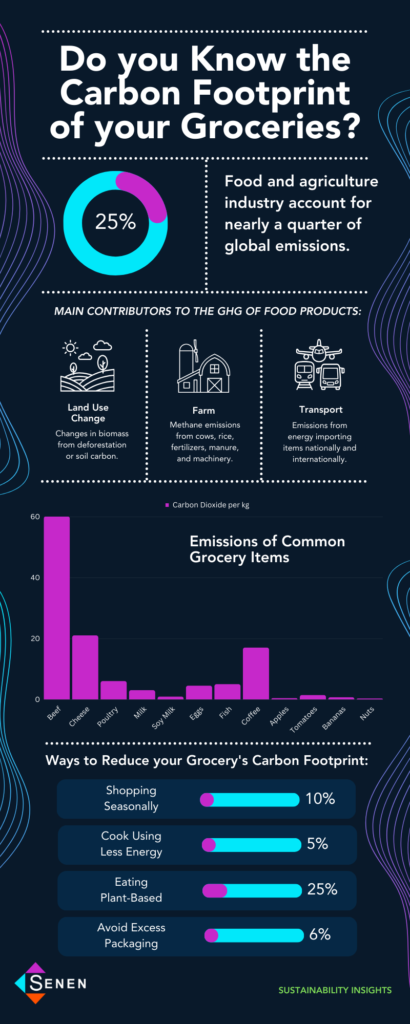Food and agriculture account for nearly a quarter of global emissions. However, unlike electricity generation and transportation, little has been done to reduce the climate impact of what we eat.
Contrasts between animal products compared to plant based alternatives can show differences in the amount of carbon emitted per kilogram. For example, whole milk emits 2kg CO2/kg compared to oat and nut milk alternatives that average 0.6kg CO2/kg.
The food you buy plays a significant role in pushing companies to reduce emissions by opting for low to net-zero carbon products. Nonetheless, such alterations need the data. Why? Because the food industry is powered by multiple layers of suppliers thqt requires an in depth analysis that only data can provide.
With the power of data, you can calculate the greenhouse gas (GHG) emissions of a common grocery list and make simple changes to reduce your carbon footprint whether you’re stocking your breakroom fridge or your own kitchen fridge at home.
Why Do Grocery Items Have a Carbon Footprint?
The carbon footprint of groceries stems from various stages of the food supply chain, from farm to fork.
Main contributors to the GHG of food products
- Land Use Change: Changes in biomass from deforestation or soil carbon.
- Farm: Methane from cows, rice, fertilizers, manure, and machinery.
- Transportation: Emissions from energy-importing items nationally and internationally.
The primary factors creating this environmental impact include:
Production Methods:
Conventional farming methods often involve the use of synthetic fertilizers and pesticides, contributing to greenhouse gas emissions. Additionally, deforestation is also a common byproduct of agricultural expansion, which releases stored carbon into the atmosphere.
Transportation and Distribution:
There is an extensive transportation process for groceries from farms to processing facilities, distribution centers, and finally to retail outlets. Long-distance transportation, especially when utilizing fossil fuels, inevitably adds to the overall environmental impact.
Food Processing and Packaging:
The processing and packaging of food also contribute to the carbon footprint. Energy-intensive processing methods and non-recyclable packaging materials further exacerbate the environmental consequences associated with grocery items.
Waste Generation:
Inefficient waste management systems further compound the environmental impact associated with groceries, as the disposal of food waste in landfills generates methane.
Ranges of Carbon Footprints by Food Group
Not all food groups contribute equally to the carbon footprint of groceries. Understanding the differences in environmental impact among various food categories is essential for making informed and sustainable dietary choices. Some food groups with higher carbon footprints include:
1. Meat and Dairy: Animal agriculture, responsible for the production of meat and dairy products, is a major contributor to greenhouse gas emissions. Livestock farming produces immense amounts of methane. At the same time, the cultivation of animal feed requires large expanses of land, often leading to deforestation.
2. Processed Foods: Processed foods, often characterized by energy-intensive manufacturing processes and extensive packaging, contribute significantly to the carbon footprint of groceries. The extraction and processing of raw materials, coupled with transportation and packaging, result in a substantial environmental impact.
3. Imported and Out-of-Season Produce: Fruits and vegetables that are imported or grown out of season locally often require long-distance transportation, contributing to increased carbon emissions.
4. Single-Use Packaging: Products with excessive or non-recyclable packaging significantly increase the carbon footprint of groceries, as single-use plastics have long-lasting consequences.
How you can Reduce your Carbon Footprint
Reducing the carbon footprint of groceries necessitates a multifaceted approach that encompasses changes in consumer behavior, industry practices, and governmental policies.
Ways to Reduce Your Grocery’s Carbon Footprint:
- Shopping seasonally – 10% reduction
- Cook using less energy – 5% reduction
- Eating plant-based – 25% reduction
- Avoid excess packaging – 6% reduction
Here are some more examples and how they can reduce your grocery’s carbon footprint:
1. Plant-Based Diets: Shifting towards plant-based diets can substantially reduce the carbon footprint of groceries. Plant-based foods generally have lower environmental impacts compared to animal products.
2. Support Local and Seasonal Produce: Opting for locally sourced and seasonal produce minimizes the carbon emissions associated with transportation and encourages sustainable farming practices. Supporting local farmers helps build resilient and environmentally conscious food systems.
3. Choose Sustainable Packaging: Prioritizing products with eco-friendly and recyclable packaging reduces the environmental impact of groceries. Consumer demand for sustainable packaging can incentivize businesses to adopt more environmentally friendly practices.
4. Reduce Food Waste: Minimizing food waste is crucial in mitigating the carbon footprint of groceries. Planning meals, proper storage, and composting can help prevent unnecessary waste, lowering methane emissions from landfills.
5. Promote Sustainable Agriculture: Advocating for and supporting sustainable farming practices, such as organic and regenerative agriculture, can contribute to reducing the overall environmental impact of food production. These methods prioritize soil health, biodiversity, and resource efficiency.
Conclusion
The carbon footprint of groceries is a critical aspect of our individual and collective impact on the environment. Recognizing the environmental consequences associated with different food groups allows consumers to make informed choices that contribute to a more sustainable and eco-friendly food system. By embracing plant-based diets, supporting local and seasonal produce, choosing sustainable packaging, reducing food waste, promoting sustainable agriculture, and advocating for policy changes, individuals can play a crucial role in mitigating the carbon footprint of their groceries.
Share these insights to help your employees meet their personal sustainability goals, so you reach your own corporate ESG goals at the same time.

Ready to unlock your organization’s full potential? Contact us today and transform your organization’s data challenges into opportunities.








